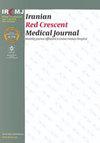Effect of Livergol on the Liver Function and its Histopathological Changes in Doxorubicin-Treated Rats
IF 0.2
4区 医学
Q3 MEDICINE, GENERAL & INTERNAL
引用次数: 0
Abstract
Background: Doxorubicin (DOX) is an effective anti-cancer medicine with serious side effects on healthy organs, especially the liver. Objectives: The present study aimed to investigate the histopathology and effects of Livergol (Liv), a product of Silybum marianum, on serum levels of hepatic parameters in long-term DOX-treated rats. Methods: Sixty three male Wistar rats were divided into seven groups, namely the control, sham, and experimental groups 1-5, which received certain doses of DOX, Liv, and their combination for 2 months. To produce a cumulative dose, 10 doses of 2 mg/kg DOX were intraperitoneally administered once every 6 days. Moreover, 150 and 300 mg/kg daily doses of Liv were gavaged to the experimental groups 2-5. In addition, blood samples were taken, serum levels of hepatic functional factors and liver enzymes were measured, and hematoxylin-eosin staining was performed to evaluate liver histopathology. The results were analyzed between experimental and control groups by analysis of variance and Tukey tests and the significance level was considered at < 0.05. Results: The serum levels of triglyceride, cholesterol, low-density lipoprotein, total and direct bilirubin, and liver enzymes in the DOX + Liv300 and Liv150 groups showed a significant decrease, compared to the DOX group. While high-density lipoprotein, albumin, and total protein showed a significant increase. Liver tissue in DOX + Liv300 and Liv150 groups did not show any damage. In addition, the serum level of liver enzymes, lipid profile, biochemical factors, and liver histopathology in the Liv300 and Liv150 groups were similar to those in the control group. Conclusion: The findings demonstrated that the oral administration of Liv powder can prevent liver side effects of DOX in rats.Livergol对阿霉素治疗大鼠肝功能及其组织病理学变化的影响
背景:多柔比星(DOX)是一种有效的抗癌药物,对健康器官尤其是肝脏有严重的副作用。目的:研究水飞蓟的产物Livergol (Liv)对长期dox治疗大鼠肝脏指标的影响及组织病理学。方法:雄性Wistar大鼠63只,分为7组,分别为对照组、假手术组和实验组1 ~ 5组,分别给予一定剂量的DOX、Liv及其联合用药2个月。为了产生累积剂量,每6天腹腔注射10次,剂量为2mg /kg DOX。实验组2 ~ 5分别灌胃150、300 mg/kg日剂量的Liv。同时取血,测定血清肝功能因子和肝酶水平,苏木精-伊红染色评价肝脏组织病理学。采用方差分析和Tukey检验对实验组和对照组的结果进行分析,以< 0.05为显著水平。结果:与DOX组相比,DOX + Liv300和Liv150组血清甘油三酯、胆固醇、低密度脂蛋白、总胆红素和直接胆红素、肝酶水平均显著降低。高密度脂蛋白、白蛋白、总蛋白明显增高。DOX + Liv300和Liv150组肝组织未见损伤。此外,Liv300组和Liv150组的血清肝酶水平、脂质谱、生化因子和肝脏组织病理学与对照组相似。结论:口服Liv粉可预防DOX对大鼠肝脏的不良反应。
本文章由计算机程序翻译,如有差异,请以英文原文为准。
求助全文
约1分钟内获得全文
求助全文
来源期刊

Iranian Red Crescent Medical Journal
MEDICINE, GENERAL & INTERNAL-
CiteScore
1.16
自引率
0.00%
发文量
0
期刊介绍:
The IRANIAN RED CRESCENT MEDICAL JOURNAL is an international, English language, peer-reviewed journal dealing with general Medicine and Surgery, Disaster Medicine and Health Policy. It is an official Journal of the Iranian Hospital Dubai and is published monthly. The Iranian Red Crescent Medical Journal aims at publishing the high quality materials, both clinical and scientific, on all aspects of Medicine and Surgery
 求助内容:
求助内容: 应助结果提醒方式:
应助结果提醒方式:


